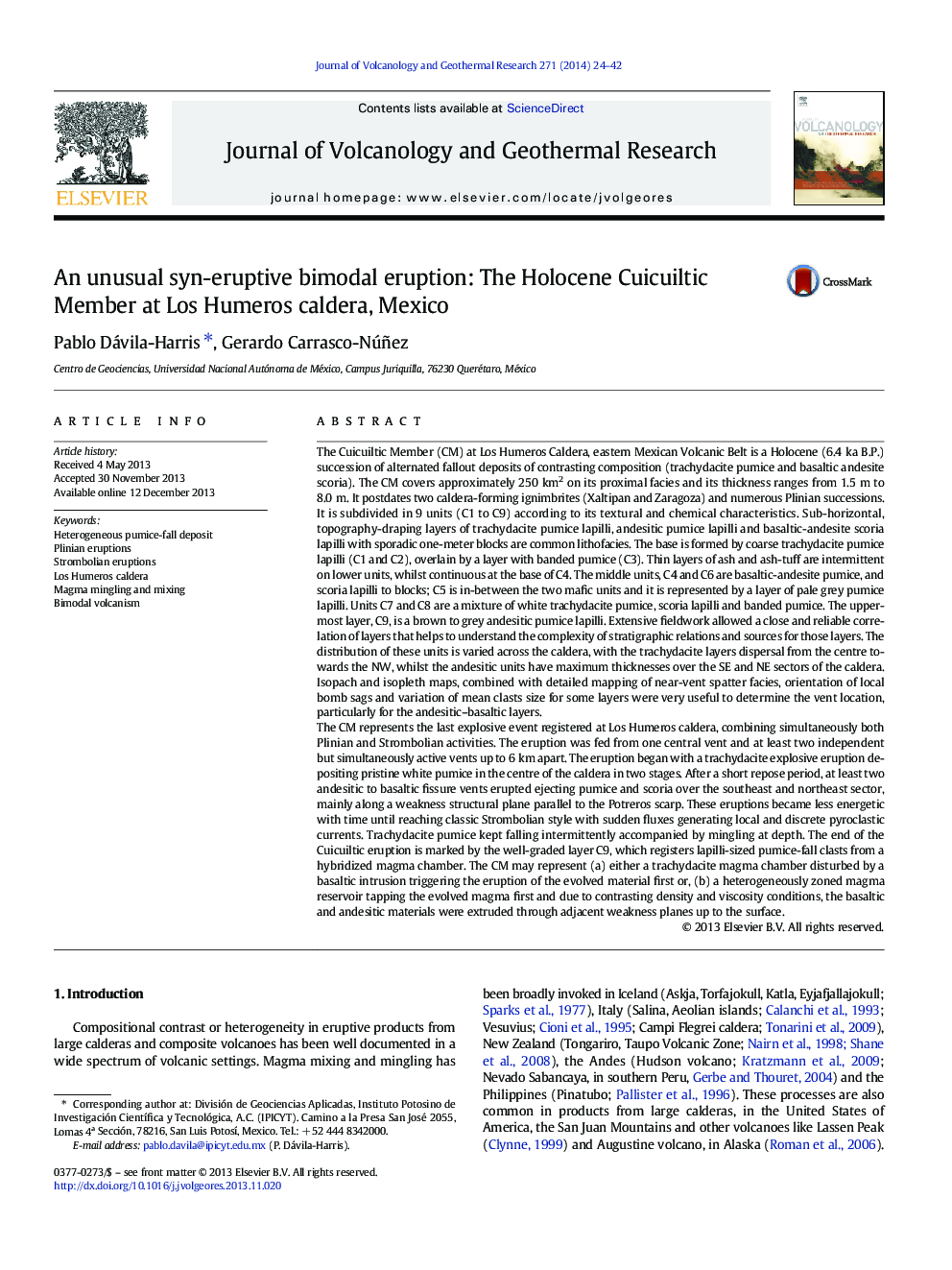| کد مقاله | کد نشریه | سال انتشار | مقاله انگلیسی | نسخه تمام متن |
|---|---|---|---|---|
| 4712423 | 1638350 | 2014 | 19 صفحه PDF | دانلود رایگان |

• The youngest explosive eruption from Los Humeros caldera has been characterized.
• A maximum calibrated 14C age of 6423 years B.P. is provided for the Cuicuiltic Member.
• Eruption consisted in a trachydacite Plinian event from the central sector of the caldera.
• At least three basaltic-andesite vents went off simultaneously from satellite fissure vents.
• Magma mingling and mixing is ubiquitous through most of the Cuicuiltic Member.
The Cuicuiltic Member (CM) at Los Humeros Caldera, eastern Mexican Volcanic Belt is a Holocene (6.4 ka B.P.) succession of alternated fallout deposits of contrasting composition (trachydacite pumice and basaltic andesite scoria). The CM covers approximately 250 km2 on its proximal facies and its thickness ranges from 1.5 m to 8.0 m. It postdates two caldera-forming ignimbrites (Xaltipan and Zaragoza) and numerous Plinian successions. It is subdivided in 9 units (C1 to C9) according to its textural and chemical characteristics. Sub-horizontal, topography-draping layers of trachydacite pumice lapilli, andesitic pumice lapilli and basaltic-andesite scoria lapilli with sporadic one-meter blocks are common lithofacies. The base is formed by coarse trachydacite pumice lapilli (C1 and C2), overlain by a layer with banded pumice (C3). Thin layers of ash and ash-tuff are intermittent on lower units, whilst continuous at the base of C4. The middle units, C4 and C6 are basaltic-andesite pumice, and scoria lapilli to blocks; C5 is in-between the two mafic units and it is represented by a layer of pale grey pumice lapilli. Units C7 and C8 are a mixture of white trachydacite pumice, scoria lapilli and banded pumice. The uppermost layer, C9, is a brown to grey andesitic pumice lapilli. Extensive fieldwork allowed a close and reliable correlation of layers that helps to understand the complexity of stratigraphic relations and sources for those layers. The distribution of these units is varied across the caldera, with the trachydacite layers dispersal from the centre towards the NW, whilst the andesitic units have maximum thicknesses over the SE and NE sectors of the caldera. Isopach and isopleth maps, combined with detailed mapping of near-vent spatter facies, orientation of local bomb sags and variation of mean clasts size for some layers were very useful to determine the vent location, particularly for the andesitic–basaltic layers.The CM represents the last explosive event registered at Los Humeros caldera, combining simultaneously both Plinian and Strombolian activities. The eruption was fed from one central vent and at least two independent but simultaneously active vents up to 6 km apart. The eruption began with a trachydacite explosive eruption depositing pristine white pumice in the centre of the caldera in two stages. After a short repose period, at least two andesitic to basaltic fissure vents erupted ejecting pumice and scoria over the southeast and northeast sector, mainly along a weakness structural plane parallel to the Potreros scarp. These eruptions became less energetic with time until reaching classic Strombolian style with sudden fluxes generating local and discrete pyroclastic currents. Trachydacite pumice kept falling intermittently accompanied by mingling at depth. The end of the Cuicuiltic eruption is marked by the well-graded layer C9, which registers lapilli-sized pumice-fall clasts from a hybridized magma chamber. The CM may represent (a) either a trachydacite magma chamber disturbed by a basaltic intrusion triggering the eruption of the evolved material first or, (b) a heterogeneously zoned magma reservoir tapping the evolved magma first and due to contrasting density and viscosity conditions, the basaltic and andesitic materials were extruded through adjacent weakness planes up to the surface.
Figure optionsDownload as PowerPoint slide
Journal: Journal of Volcanology and Geothermal Research - Volume 271, 1 February 2014, Pages 24–42